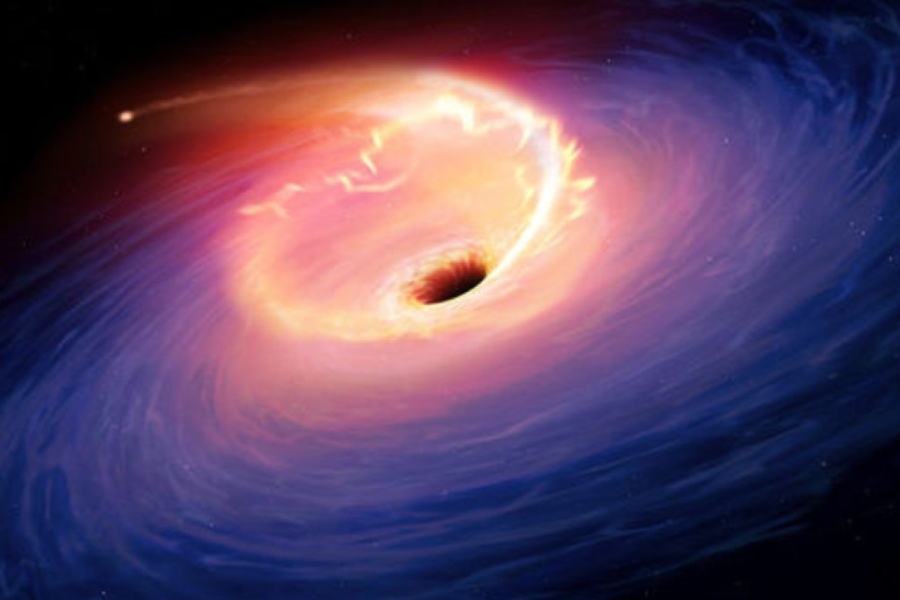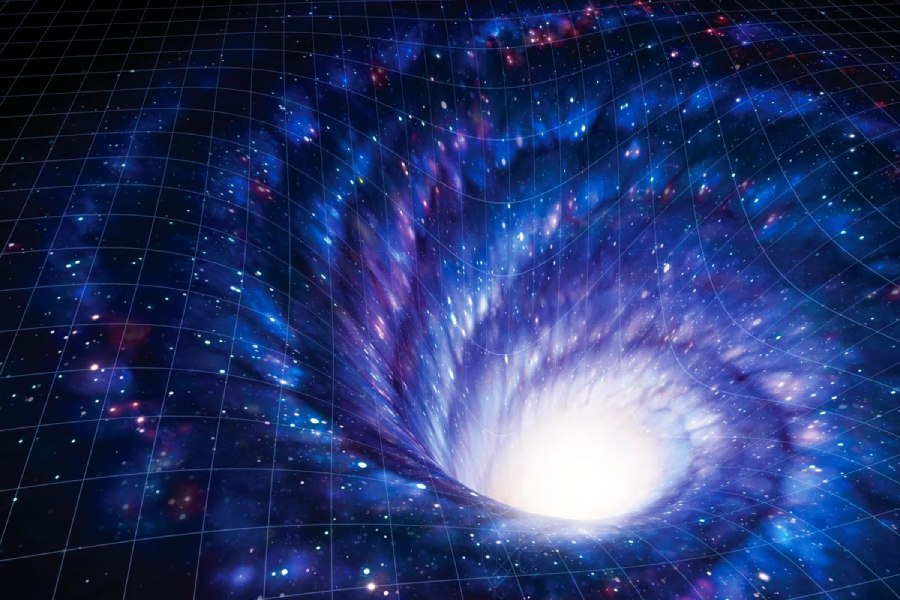Wormholes and black holes seem plucked straight from science fiction. Wormholes theoretically tunnel through the cosmic fabric, offering shortcuts for space travel. Black holes instead irreversibly consume anything entering their crushing gravitational domain. But what is the difference between a wormhole vs black hole?
This article compares two massive and fascinating objects in space: wormholes and black holes. We’ll examine their characteristics, scientific support, and limitations. Learn what makes a wormhole traversable compared to unstable Schwarzschild bridges.
We’ll also look at recent black hole images and visualizations hinting at tunnel-like passages. Come along as we delve into the evidence and weigh in on the ongoing debate of wormholes versus black holes.

Wormhole vs Black Hole: Key Differences in Nature
Black holes and wormholes both stem from Einstein’s theory of general relativity, but they are quite different in nature. Black holes pull surrounding matter and light with an incredibly strong gravitational force. Once something crosses the event horizon, it’s stuck inside forever.
At the heart of black holes is a gravitational singularity, a point where density becomes infinite, and the laws of physics no longer apply. Wormholes, however, function more like tunnels through spacetime. While some wormhole models include singularities, their primary feature is a tunnel-like structure.
This structure is thought to link distant parts of space and time. Unlike black holes, wormholes might not naturally possess intense gravitational fields. However, keeping their “throats” open and traversable requires exotic theoretical matter.
What Are the Differences Between Wormhole and Black Hole?
A wormhole and a black hole are fascinating cosmic phenomena, but they are quite different. A black hole is like a bottomless pit in space, where gravity is so strong that nothing, not even light, can escape from it.
On the other hand, a wormhole is like a tunnel that connects two different parts of the universe, possibly allowing for shortcuts in space travel. In simple terms, a black hole is a cosmic vacuum cleaner, while a wormhole is a hypothetical cosmic shortcut.
Space-time manipulations: Time dilation to time travel
A key difference between black holes and wormholes is that black holes distort the flow of time through time dilation. This time dilation slows clocks observed near the event horizon. Wormholes, in contrast, may allow time travel and closed timelike loops.
This introduces causality paradoxes that are not fully resolved. Both black holes and traversable wormholes represent extreme spacetime geometries. However, black holes have some well-defined features.
They clearly have defined singularities and exert strong gravitational attraction. Yet, the internal structure of traversable wormholes is less clearly specified. Despite this, traversable wormholes could enable time travel over cosmic distances.
Structure of wormholes and black holes
Wormholes and black holes are quite different in how they’re theorized. Wormholes are like tunnels in spacetime, having two openings connected by a throat. They can take on complex shapes and even link faraway points in space and time.
Some wormhole models include singularities but don’t necessarily possess mass or gravity. Instead, they rely on exotic matter to keep their throats passable.
In contrast, black holes have a more defined structure. They feature a spherical event horizon boundary surrounding a central gravitational singularity of infinite density. This singularity packs immense mass and energy into a very small space, producing remarkable effects.
Opposing energy profiles: Negative energy to positive mass
Extremely strong gravitational fields form around black holes, which can bend light and warp spacetime. As more matter and radiation are pulled in, the black hole grows in mass and energy. The incoming matter and radiation become compressed. Traversable wormholes, however, need negative energy.
In contrast, black holes accumulate immense positive mass-energy inside them. This difference shows a significant contrast between these two spacetime phenomena. While both black holes and traversable wormholes greatly distort spacetime, their internal structures and energy profiles vary greatly.

Time dilation in relation to both
Black holes slow down time a lot because of their strong gravity. Clocks tick slower the closer an observer gets to the edge called the event horizon. Time practically stops at the very center of a black hole.
Wormholes, on the other hand, don’t have their gravity or mass. So, time doesn’t slow down as much around them. However, the strange stuff needed to keep them open, called exotic matter, might still affect time a bit. There might be some mild time slowing down near the openings of wormholes.
Time dynamics: Dilation to theoretical time travel
Traversing through a wormhole could send things to different times – the past or the future, opening up the idea of time travel. This is different from what happens near a black hole, where time only moves forward.
Near a black hole, gravity causes time to slow down as you get closer to its center. Even though both involve the bending of spacetime, wormholes allow travel both ways through time, while black holes only lead forward. Black holes show extreme gravitational time dilation, while wormholes suggest the potential for time travel through warped spacetime.
Use of wormholes and black holes in science fiction
In science fiction stories, wormholes and black holes often play important roles in space travel and exploration. Wormholes are like passages that allow characters to travel faster than light, connecting faraway places in space or even at different points in time. They’re used by characters to zip across huge interstellar distances quickly.
On the other hand, black holes are unpredictable dangers. Their incredibly strong gravity can pull in anything nearby, whether it’s a spaceship or an entire planet. This creates tense moments in stories and can lead to strange effects like time slowing down or speeding up, adding to the excitement.
Theoretical Possibilities for Both Phenomena
The exotic nature of wormholes and black holes opens doors to intriguing theoretical possibilities. One such speculation is their connection: could black holes be wormholes in disguise?
This theory proposes that wormholes might connect distant black holes across space, acting as passages between them. Wormholes may also act as time machines, transporting objects to different eras. Black holes could potentially lead to new universes in a couple of ways.
One possibility is that they lead to new universes through holographic models. In these models, the physics of a lower dimensional space is encoded on the boundary surface of a higher dimensional space.
Another possibility is that black holes connect to new universes via wormholes. The same wormholes that may link distant black holes could also bridge different universes.
Speculation prompted by strange physics
These exotic ideas involve several speculative concepts. Some concepts include time travel and exploring parallel universes. Other ideas involve using wormholes as tunnels spanning intergalactic distances between black holes.
While grounded in cutting-edge physics, concrete evidence for such scenarios remains lacking. Nevertheless, the sheer strangeness of warped spacetime around wormholes and black holes continues to inspire exotic flights of theoretical speculation.
Opening the door to amazing possibilities beyond our own cosmic horizon. More observations and research are needed to uncover what potentials these phenomena may truly enable.
The Existence of Traversable Wormhole vs Black Hole
The notions of traversable wormholes and stable black holes arise from solutions to Einstein’s field equations. However, their existence remains speculative and unsupported by observations.
Traversable wormholes would require exotic matter with negative energy. This would keep their hypothetical tunnels open and passable. While such matter is allowed by quantum theory, it has not been detected.
Stable black holes likely exist as supermassive varieties of billions of solar masses. These black holes evaporate slowly via Hawking radiation. Their lifespans could exceed the age of the universe.
Additionally, some smaller primordial black holes may persist as stable remnants. Traversable wormholes and stable black holes are grounded in real physics. However, they remain hypothetical and unproven.
Further observations and experimentation may reveal more definitive evidence regarding these exotic astrophysical phenomena. This could reveal whether their intriguing theoretical possibilities can be realized in nature. For now, their existence is suggested but not confirmed.
Conclusion
What is the difference between a wormhole vs black hole? The comparison between wormholes and black holes reveals fascinating disparities in their nature and theoretical implications.
While black holes epitomize immense gravitational forces and irreversible consumption, wormholes suggest the possibility of cosmic shortcuts and even time travel. Despite both originating from Einstein’s theory of relativity, they diverge significantly in their structural makeup, energy profiles, and effects on spacetime dynamics.
Moreover, while traversable wormholes and stable black holes remain theoretical constructs, further research and observation may unveil their true existence. This could lead to potential implications for our understanding of the universe.
